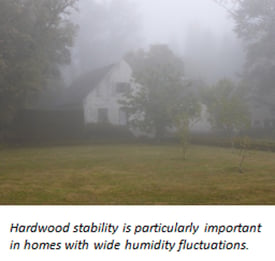When the humidity fluctuates in a room, or an entire home, hardwood flooring will shrink or expand. As wood loses moisture, it contracts. As it gains moisture, it expands.
The degree to which this occurs for a particular species of wood is known as “species dimensional stability." Red Oak, White Oak, and Ash are examples of woods with high stability. Maple, Hickory, and Cumaru are examples of less-stable species.
 It’s important to know the stability of the woods you’re considering—particularly if the flooring will be in a home that experiences wide swings in temperature or humidity.
It’s important to know the stability of the woods you’re considering—particularly if the flooring will be in a home that experiences wide swings in temperature or humidity.
Preventing Cupping and Gapping
The more stable a wood is, the less likely it is to cup (when the edges of a wood plank become higher than its center) or to gap (when spaces open up between planks).
Another factor in preventing cupping and gapping is the width of the flooring planks—narrower boards will show less movement than wider boards.
It's important to have the floors installed by professionals who understand how moisture will impact wood and who have the experience to make adjustments during installation to achieve optimal long-term results.
Manufacturers recommend bringing the wood into the house several days before installation to allow the floor to acclimate to the conditions of the home. We have a different approach at Ralph’s.
Acclimating within a home during the summer results in the floor taking on too much moisture, causing gapping for most of the year. Acclimating in winter results in the floor becoming too dry, causing cupping most of the year. The right approach is to acclimate the wood (before it’s brought into the home) to a moisture level between the high and low moisture levels the home will experience and/or to allow the floor to have extra room for growth.
Also, in the case of installations in homes under construction, the houses are often not being heated or cooled yet, so acclimating to those conditions is actually counterproductive. Even if the HVAC is already running, the concrete, plaster, and paint often raise the humidity level.
To ensure they are placing boards correctly, professional installers who truly understand wood will ensure that the boards are acclimated to the average living environment to which they will be exposed.
Subfloors
Prior to installation, a veteran installer will also address any problems related to the subfloor's moisture level, which should not be much more than that of the wood, Otherwise, the wood will excessively pick up moisture from the subfloor and the rest of the home. That's why we monitor the moisture level and won’t install until the conditions are right—and why we'll provide a dehumidifier to remove excess humidity prior to installation.
In cases where radiant floor heat is used or the installation is below ground, engineered wood is almost always the better choice because of its greater stability, and hardwood flooring specialists can help you make that determination.
Ralph’s is glad to offer our expert advice to help you select the right species for your home, environment, and lifestyle. Please give us a call (920-984-3383 or toll free 800-354-9902) or stop by our showroom.















